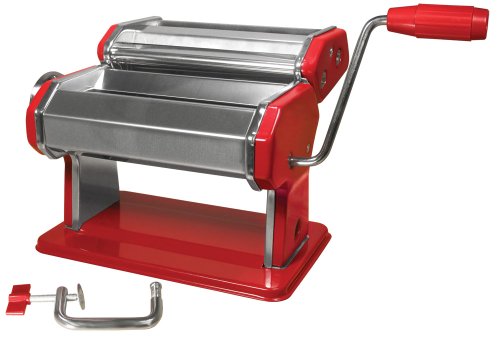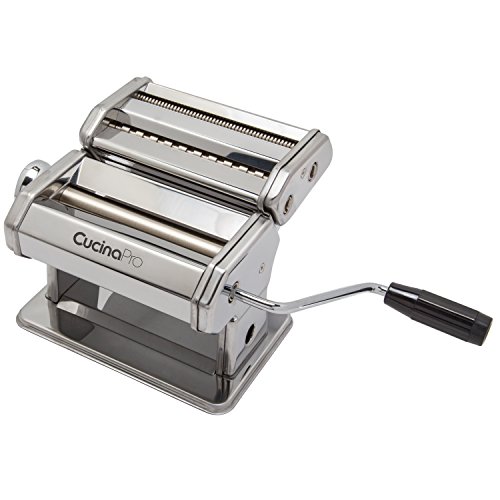
Who doesn’t enjoy homemade pasta?

If you’re used to store-bought pasta, you might be ready to take things to the next level of deliciousness by making your own fresh homemade pasta right at home. Making homemade pasta by hand can be a bit tedious, though. Lucky for us, you don’t have to do it the old fashioned way.
The best pasta makers can help you make fresh homemade pasta quickly and easily. But before you hand over your money for a shiny new machine, there are a few things to keep in mind to ensure you get the best pasta maker machine for your “dough” (pun intended).
There are two main types of pasta makers: manual and automatic. A manual pasta maker can make the pasta-making process easier, but they still require some work.
Manual pasta makers have pasta roller and a manual handle that you crank to make the best pasta. They’re perfect for making long noodles like spaghetti and fetuccine. A manual pasta maker is more affordable than automatic pasta makers and can last for a long time.
Automatic pasta makers do most of the work for you. They are more expensive than manual pasta machines, but they are faster and easier to use. They also allow you to make more pasta styles, including round pastas like macaroni and ziti.
On your search for the best pasta makers, there are some factors to keep in mind.
Do you anticipate using the machine once or twice per month? Or do you make homemade pasta several times per week? If you’re an occasional pasta maker, a manual machine can easily meet your needs, capable of handling a wide range of pasta shapes to help you make fresh pasta with ease.
If fresh pasta is an essential part of your diet, you may want to consider electric pasta makers so you can make fresh pasta more easily. Manual machines can also work well for making large batches of pasta; it just takes a bit longer. The hands-on experience of using a manual pasta and noodle maker may be appealing as well, working with your hands to create pasta shapes from fresh pasta dough can be a rewarding experience.
Pasta machines can vary widely in price. Manual machines start as low as $15, and automatic machines start at around $75. As with most purchases, the brand is a big influence on the price. Higher quality brands may be more expensive, but they also tend to last longer.
The price of pasta machines is also influenced by the number of different pastas you can make, how easy it is to use, and how easy (or hard) it is to clean.
If you’re short on space, you want to look for a machine with a smaller profile. Larger machines can make larger sheets of pasta, though, so it’s a balancing act. Most automatic machines are roughly the size of a coffee maker. Manual machines vary, and you can find machines that are 18 inches wide or more.
If there’s a specific type of pasta you particularly enjoy, such as pasta sheets, lasagna noodles, fettuccine cutter, or different pasta shapes, then you should look for a machine that can easily make that type of pasta shapes. For specialty pastas like ravioli, you may need to purchase an attachment in addition to the pasta machine. Automatic pasta machines often have a wider range of pasta options, but the attachments available for manual machines can make them flexible as well.
Pasta machines can be a challenge to clean. The pasta dough can work its way deep into the crevices of the machine. If you can easily take apart the machine, that can make it much easier to clean. Even better if you can throw parts into the dishwasher, which is a more common feature with automatic machines.
If you’re not the most patient person, you may want to consider speed as you shop for pasta makers. Manual pasta machines tend to be a bit slower, while automatic machines, with their electronic components are faster. The speed of automatic machines vary, so check reviews if this feature is a priority for you.
Many manual pasta machines also have an option for buying a motor, which can give you the best of both worlds when it comes to making pasta.
Any pasta machine is going to improve your pasta making experience. The best electric pasta maker models will do more of the work for you, including mixing and kneading the pasta dough. Manual machines press out the pasta for you as you turn the crank, and they should be easy to adjust for different pasta thicknesses. They should include a vice to keep it secured to your table or kitchen counter. The handle should be relatively easy to turn.
If you go with a manual machine, you can use a food processor or stand mixer to make the dough to make the process easier.
Manual machines are more durable than automatic machines. They don’t have electric components that will wear out. Manual machines can have an extremely long life if they are properly cleaned and maintained. For the longest life when it comes to manual machines, look for models with all-metal and stainless-steel parts. Many brands also offer a warranty, which is an important factor to keep in mind while you shop for the best pasta machine makers.
Once you know what to look for in a pasta maker, the selection of machine makers is nearly endless. Here are the top pasta maker machines, each of which will make your pasta making experience easier and more fun.
Since manual machines are affordable, durable, and fun to use, the top pasta machines are all manual models. They’re perfect for pasta novices as well as experienced pasta makers.

The Weston Manual Pasta Maker is a small but mighty option for your pasta-making needs. Its attractive, bright red exterior makes it a welcome addition to any kitchen. Weston prides itself as a brand for food traditionalists and enthusiasts.
Made by: Weston
Product Dimensions: 8 in. by 8.5 in. by 6.5 in.
Weight: 6.6 pounds
Reasons to buy / Pros:
Cons:

The Marcato’s Atlas Pasta Maker Machine has been called the Ferrari of pasta machines by Cook’s Illustrated. This Italian pasta machine easily handles a variety of pastas, and the Marcato name is associated with high-quality, durable machines.
Made by: Marcato Atlas
Product Dimensions: 8 in. by 8 in. by 7 in.
Weight: 3 pounds
Reasons to buy / Pros:
Cons:

The CucinaPro Deluxe Pasta Maker includes everything you need to make a variety of pastas, including ravioli, spaghetti, and fettuccini. CucinaPro is a respected name in the culinary world and the company is dedicated to inspiring creativity.
Made by: CucinaPro
Product Dimensions: 8 in. by 7.75 in. by 6 in.
Weight: 16 pounds
Reasons to buy / Pros:
Cons:

The Imperia Pasta Maker Machine is a solid machine that is made in Italy. It’s a high-end machine with a double cutter. You can easily adjust the thickness and it’s also simple to use, even for novice pasta chefs.
Made by: Imperia
Product Dimensions: 8.1 in. by 7.2 in. by 6.2 in.
Weight: 7.61 pounds
Reasons to buy / Pros:
Cons:

The Atlas Marcato Multipasta Pasta Machine Set comes with everything you need to make a variety of pastas. It has a variety of thickness settings and includes hour removable cutting plates.
Made by: Marcato Atlas
Product Dimensions: 7.87 in. by 8.15 in. by 6.1 in.
Weight: 11.93 pounds
Reasons to buy / Pros:
Cons:

The CucinaPro Pasta Maker Machine is a sleek, sturdy addition to your kitchen. It’s heavyweight and durable enough for years of pasta-making enjoyment. It can make spaghetti, fettuccine with the included attachments, and you can purchase additional attachments for more variety.
Made by: CucinaPro
Product Dimensions: 8 in. by 7.75 in. by 6 in.
Weight: 5.8 pounds
Reasons to buy / Pros:
Cons:

The Imperia iPasta Limited Edition is easy to use and simple to clean. Made in Italy, it’s versatile and can make tagliatelle and fettuccine with each. You can purchase additional attachments to make a wider variety of pastas.
Made by: Imperia
Product Dimensions: 8.3 in. by 7.3 in. by 6.9 in.
Weight: 7.98 pounds
Reasons to buy / Pros:
Cons:

The Atlas Ampia Pasta Machine is a versatile machine that makes consistent, tasty pasta. It’s small but sturdy and fully adjustable. It’s made in Italy and comes from a brand known for its quality machines.
Made by: Marcato Atlas
Product Dimensions: 8 in. by 5.5 in. by 8 in.
Weight: 3 pounds
Reasons to buy / Pros:
Cons:

The VonShef 3-in-1 Pasta Maker Machine is able to make a wide variety of pastas easily. It’s made from sturdy stainless steel and can make spaghetti, fettuccine, linguine, and tagliatelle.
Made by: VonShef
Product Dimensions: 13 in. by 9.7 in. by 6.5 in.
Weight: 11.85 pounds
Reasons to buy / Pros:
Cons:
Attachments can add variety to your pasta-making experience. Common attachments include motors and ravioli makers. Attachments are available from Imperia, Marcato Atlas, and Weston.
There are several factors to consider when choosing a pasta maker, and the best brand will depend on your specific needs and preferences. Some popular brands of pasta makers include Imperia, Marcato, and Atlas.
Imperia is a well-known brand that offers a range of manual and electric pasta makers. Their products are made of high-quality materials and are known for their durability and ease of use.
Marcato is another popular brand that offers a wide selection of manual and electric pasta makers. Their products are known for their durability and ease of use, and many come with a variety of attachments for making different types of pasta.
Atlas is a well-respected brand that offers a range of manual and electric pasta makers. Their products are known for their durability and ease of use, and many come with a variety of attachments for making different types of pasta.
Ultimately, the best brand for you will depend on your budget, the types of pasta you want to make, and your personal preferences. It may be helpful to read reviews and compare the features of different brands to find the one that best meets your needs.
Electric pasta makers are generally easier to use, as they can handle the dough mixing and shaping process automatically. They are also faster than manual pasta makers, as they do not require manual labor. However, they tend to be more expensive and require access to an electrical outlet. They may also be less portable and take up more space in the kitchen.
Manual pasta makers, on the other hand, are generally more affordable and do not require access to an electrical outlet. They are also more portable and take up less space in the kitchen. However, they require manual labor to mix and shape the dough, which can be time-consuming and tiring. They may also be less consistent in their results compared to electric pasta makers.
If you love pasta as much as we do, then having the ability to make fresh, delectable pasta right in your own kitchen sounds like a dream come true. But for most of us, making pasta by hand just isn’t a viable option (who has time for that).
Luckily, the best pasta makers detailed in this guide are just what you need to make pasta fast…right in your own kitchen. Not all pasta makers live up to their reputation, but the models we’ve reviewed in this guide have lived up to the highest of standards and are worth a try.